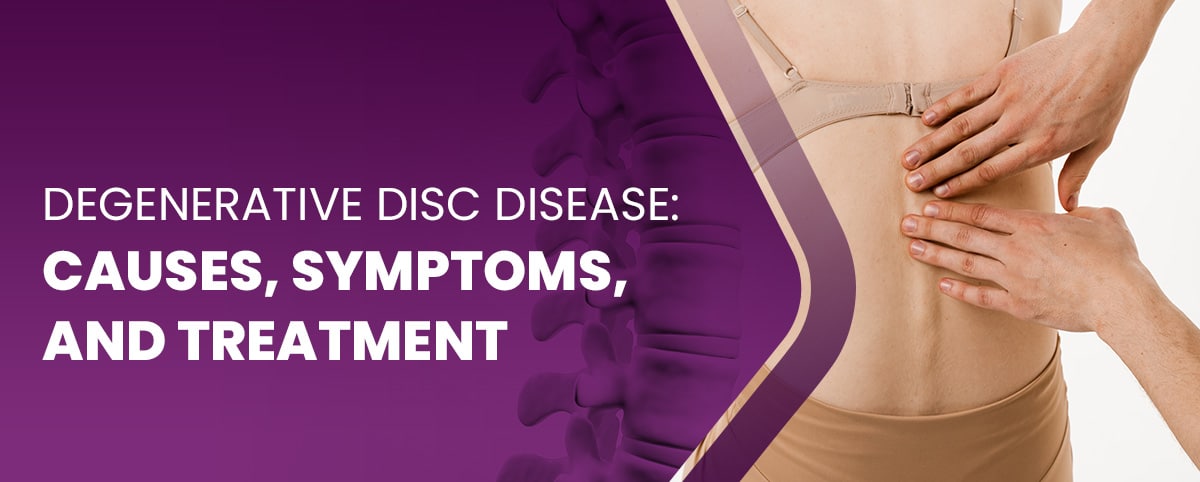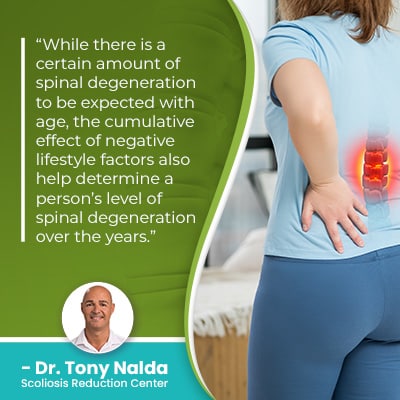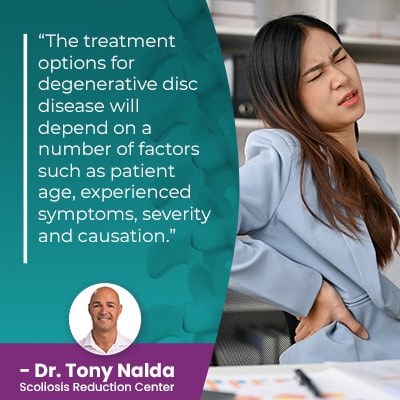Degenerative Disc Disease: Causes, Symptoms, and Treatment

The spine consists of many important moveable structures, and just like the rest of the body, the spine is subject to degenerative changes associated with aging. If one or more of the spine’s intervertebral discs is deteriorating, it can affect the function of the spine in many ways.
The discs of the spine are important structures, and degenerative disc disease involves the slow age-related degeneration that one or more discs can experience. The spinal discs are generally the first spinal structures to feel the effects of deterioration; symptoms and treatment are case-specific.
Before getting to the specifics of disc anatomy and degeneration, let’s take a moment to talk about general spinal anatomy.
Table of Contents
Anatomy of a Health Spine
Understanding the anatomy of a healthy spine is helpful when it comes to understanding the importance of its intervertebral discs.
The spine plays many important roles including allowing us to stand upright, practice healthy posture, bend, twist, and turn, and in addition, it works with the brain as part of the central nervous system (CNS).
In light of these many key roles, it’s clear how spinal conditions can cause such a wide range of symptoms and effects felt throughout the body.
The spine consists of vertebrae (bones) stacked on top of one another in a straight and neutral alignment.
When healthy spines are viewed from the front and/or back, they will appear straight, but when viewed from the sides, it will have a soft ‘S’ shape, and this is because of the spine’s healthy curves.
The spine is curved at each of its main sections: cervical spine (neck), thoracic spine (middle/upper back), and lumbar spine (lower back).
The spine’s natural and healthy curves facilitate its optimal function by making it stronger, more flexible, and better able to absorb/distribute mechanical stress.
The vertebrae are separated by intervertebral discs, with a disc between adjacent vertebrae, and these discs also play many important roles in maintaining spinal health and function.
If the spine loses one or more of its healthy curves, the entire biomechanics of the spine are disrupted.
Intervertebral Disc Structure
The discs consist of two main parts: an inner gel-like interior known as the nucleus and a tough and durable outer layer known as the annulus.
The spine’s intervertebral discs are made of water, collagen, and proteoglycans.
The spinal discs are the largest structures of the body that don’t have their own vascular supply, meaning a direct path in and out of the discs for transporting nutrients and oxygen in, and eliminating waste.
Because the discs are lacking their own vascular supply, once they start to deteriorate, it can be difficult to reverse the process.
What is Degenerative Disc Disease?
So degenerative disc disease involves the deterioration of one or more spinal discs due to age-related degeneration.
 While there is a certain amount of spinal degeneration to be expected with age, the cumulative effect of negative lifestyle factors also help determine a person’s level of spinal degeneration over the years.
While there is a certain amount of spinal degeneration to be expected with age, the cumulative effect of negative lifestyle factors also help determine a person’s level of spinal degeneration over the years.
Factors such as carrying excess weight, leading a sedentary lifestyle, chronic poor posture, heavy consumption of alcohol and smoking, and repeatedly lifting heavy objects with the back, rather than the legs, can also impact the health of the spine, and its discs.
Now that we have defined the condition, what types of degenerative disc disease symptoms should a person be looking for?
Symptoms of Degenerative Disc Disease
While the discs in any of the spine’s sections can experience degeneration, degenerative disc disease is most commonly found in the lumbar and cervical spinal sections.
The vertebrae of the lower back are sometimes referred to as the stress vertebrae, and this is because they have to support the weight of the spinal sections above, the trunk, and they also feel the effects of bending, twisting, and lifting motions.
The cervical spine has to support the weight of the head and facilitate the turning and bending of the neck.
So pain in the spinal section affected is a common symptom of degenerative disc disease.
It is important to understand, however, that each patient will experience their own unique set of symptoms including:
- Back pain in the affected spinal section
- Back pain that intensifies during long periods of sitting (discs of the lower back have an increased weight load)
- Difficulty with bending, lifting, and twisting (painful)
- Pain that lessens with a change of position or when lying down
- Radiating nerve pain felt in the body’s extremities (determined by the degree of nerve involvement)
- Painful flare-ups that can range from mild to severe
- Muscle weakness (legs)
In most cases, the condition causes chronic pain that varies in intensity due to the frequency of flare-ups.
Now that we understand some common symptoms and signs of degenerative disc disease, let’s move on to some of the condition’s common causes.
Causes of Degenerative Disc Disease
As mentioned, degenerative disc disease is mainly caused by natural age-related spinal degeneration, and when it comes to disc deterioration specifically, we’re talking about a disc becoming excessively dried out: disc desiccation.
When we’re born, the discs are made of 80-percent water, but over time as we age, the discs lose fluid, with certain lifestyle factors speeding up the process.
When a disc experiences significant fluid loss, desiccated discs lose height and change shape.
Now, the discs play some key roles in maintaining general spinal health and function: acting as the spine’s shock absorbers, providing the spine with structure, combining forces to facilitate flexible movement, and providing cushioning between adjacent vertebrae.
If one or more of the spine’s discs start to lose height, this affects the position of adjacent vertebrae, as they attach to the disc in between, not to mention impacting the spine’s ability to evenly absorb and distribute mechanical stress incurred during activity.
So while most people over the age of 50 are going to experience various levels of spinal degeneration, not everyone will develop degenerative disc disease.
Risk factors for degenerative disc disease include poor lifestyle choices, as mentioned earlier, a spine that’s experienced a significant trauma and/or injury, and the presence of another spinal condition such as scoliosis or osteoporosis.
So if a person is diagnosed with degenerative disc disease, what are the treatment options?
Treatment for Degenerative Disc Disease
 The treatment options for degenerative disc disease will depend on a number of factors such as patient age, experienced symptoms, severity and causation.
The treatment options for degenerative disc disease will depend on a number of factors such as patient age, experienced symptoms, severity and causation.
If another spinal condition is contributing to excessive wear and tear experienced by the discs, the underlying condition has to be the guiding force of treatment.
When it comes to the majority of patients with degenerative disc disease who developed it due to natural age-related spinal degeneration, here at the Scoliosis Reduction Center, I treat patients with a proactive conservative treatment approach.
Just as disc degeneration occurs slowly over time, the process of working towards reversing some of that damage can also be lengthy.
The goal is to be proactive so progression isn’t significant as it’s far simpler to preserve disc health and function early, than trying to reverse the effects of disc degeneration that has gotten increasingly worse over time.
When it comes to restoring dis health, there is no quick fix; instead, multiple condition-specific treatment disciplines can be applied to work towards preserving disc health and function, and improving the health of the affected disc’s surroundings.
In patients whose disc degeneration is the result of age-related spinal degeneration, I can focus on the discs and their surroundings through chiropractic care and physical therapy.
Chiropractic Care
Chiropractic care can help reduce tension in related muscles and joints, and precise manual adjustments can apply force and pressure to counteract the compression experienced by the spine, its discs, and their surrounding muscles, nerves, and ligaments.
In addition, chiropractic care can impact the structure of the spine by addressing any areas of vertebral subluxation that can be impacting the discs in between.
By working towards repositioning certain vertebrae so the spine can be realigned, this takes pressure off the discs and the affected disc’s surroundings.
Physical Therapy
When it comes to physical therapy, remember, it’s not just the spine and its parts that are responsible for maintaining its natural curves and alignment, but also the spine’s surrounding muscles and ligaments.
Therapeutic stretches and strengthening exercises can help strengthen the spine, improve its mobility, and keep the muscles surrounding the spine, hips, and pelvis as loose and strong as possible: helping to take pressure off the spine and the spinal discs.
As the very design of the spine is based on movement, a series of exercises and stretches can also help increase circulation, which includes the areas around affected discs, and as the discs don’t have their own vascular supply, they absorb nutrients needed for restoration and repair from their surroundings.
Increasing circulation is key to improving the health of the affected disc’s surroundings as this can improve its health, function and ability to restore itself.
Lifestyle Guidance
As mentioned earlier, certain lifestyle factors play a large role in the level of spinal degeneration experienced with age, so addressing these variables through lifestyle guidance can be very helpful in preventing further disc damage, not to mention preserving disc function.
Losing excess weight can mean less pressure on the spine, its joints, and discs, and regular movement helps keep the spine and its surroundings loose, flexible, and strong, while also increasing circulation.
Excessive levels of alcohol consumption and smoking dehydrate the body over time, including the discs, so avoiding these habits can help preserve the body’s, and the affected disc’s, fluid levels.
Learning how to practice healthy posture and properly lift heavy objects decreases the risk of injury and exposing the spine to uneven wear and tear that, over the years, can increase the rate of spinal degeneration.
Conclusion
Just like the rest of the body, the spine is subject to the degenerative effects of aging, and most often, it’s the spine’s intervertebral discs that are the first to feel those effects.
In light of the many key roles the discs play in maintaining spinal health and function, it makes sense that they are also the most vulnerable to deterioration and the cumulative effect of certain lifestyle choices.
Degenerative disc disease means one or more of the spine’s discs are deteriorating, becoming desiccated, changing shape, and affecting the position and health of nearby vertebrae and their surroundings.
Just as the effects of spinal degeneration develop over time, the process of improving disc health and function, while reversing some of those effects, can be equally complex and time consuming.
Through the integration of different types of treatment such as chiropractic care and physical therapy, the goal is to improve the overall health of the spine by ensuring its vertebrae are aligned as they should be, strengthening nearby muscles so the spine is optimally supported and pressure is taken off the spinel and its discs, and improving circulation so nutrients needed by the discs for restoration are more accessible.
Dr. Tony Nalda
DOCTOR OF CHIROPRACTIC
After receiving an undergraduate degree in psychology and his Doctorate of Chiropractic from Life University, Dr. Nalda settled in Celebration, Florida and proceeded to build one of Central Florida’s most successful chiropractic clinics.
His experience with patients suffering from scoliosis, and the confusion and frustration they faced, led him to seek a specialty in scoliosis care. In 2006 he completed his Intensive Care Certification from CLEAR Institute, a leading scoliosis educational and certification center.
About Dr. Tony Nalda
 Ready to explore scoliosis treatment? Contact Us Now
Ready to explore scoliosis treatment? Contact Us Now





